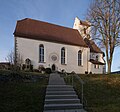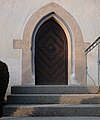Village church of Öfingen
The village church of Öfingen is a monument in Bad Dürrheim - Öfingen in the Black Forest-Baar district . The Protestant parish of Öfingen is part of the Villingen parish of the Evangelical Regional Church in Baden .
history
Öfingen is one of the early Baar parishes . This is also indicated by the patronage of the Holy Cross of the Öfinger Church. In the monastery Reichenau one was from the 10th century cross relic revered, and the Bodensee monastery was probably also the owner Öfingens. Structural elements from the first Romanesque stone church have been preserved to this day. It was the parish church for the places Oberbaldingen , Unterbaldingen , Ippingen and several deserted areas.
The first written mention of Öfingen can be found in 1275 in a directory of the Diocese of Constance , in which the dues of the clergy for a planned crusade are listed. In the Constance Liber quartarum of 1324, the parish of Öfingen is listed in the Trossingen deanery; the quart was a levy to the bishop collected from the early parishes. This also indicates that the Öfinger parish is very old.
The right of patronage passed from the Reichenau monastery to the barons of Wartenberg and was divided into three parts in the 14th century. In the 15th century the Fürstenberg family was the sole patron saint.
The reformer of the Tuttlingen region was Ambrosius Blarer . The village of Öfingen was located on a border, both the dukes of Württemberg and the counts of Fürstenberg tried to assert their rights here. The two subsidiary communities of Ippingen and Unterbaldingen were separated from the mother parish of Öfingen in the 16th century because they remained Catholic as the Fürstenberg bailiwicks. Their dead continued to be buried in the Öfinger churchyard.
During the Thirty Years War the nave was in ruins and the services were celebrated in the choir. Later a coffered ceiling made of fir wood was installed.
In the 1960s, the Öfinger church was extensively renovated. A large baroque sundial came to light above the south gate (1613/1614).
Building description
The Öfinger church is in an exposed position: from the middle village a steep old staircase leads up to the church and the cemetery. It has a rectangular nave and a polygonal choir. The church tower is to the north of the choir.
The tower has the stepped gables typical of the Baar . The lower part of the tower probably belongs to a previous building, namely as the choir of the small church. The oldest parts of the current church are Romanesque: a herringbone pattern in the chancel and the gate that leads from the choir into the bell chamber (ie into the basement of the church tower).
Overall, the Öfinger Church is a Gothic building , as can be seen from the choir arch, south gate and choir ceiling. Remnants of the choir painting ( Evangelist Johannes on the desk) have been preserved on the north wall. The Gothic pointed arch windows were converted into round arch windows in the 1820s.
The sacristy south of the choir is a younger extension. The present sacristy was built in 1839. The pulpit and altar date from 1841; the altar crucifix is a baroque work that is attributed to the Schupp workshop in Villingen.
Church inventory
Most of the medieval church furnishings were removed after the Reformation. Initially, the objects were brought to Amtenhausen, and in the 20th century, three wooden figures of saints from Öfingen are said to have been in the Sunthausener mill.
During the renovations in the 19th century, the Gothic font was considered “unworthy”. It was just a stone bowl broken into pieces on a brick stand, plastered white with lime. So the baptismal font was removed in 1844 and made into a container for the rainwater in the parish barn. Later it was used as a basin for washing potatoes and as a flower pot. The Öfinger baptismal font has been privately owned in Stuttgart-Heumaden since 1957.
The church clock is mentioned as early as 1605 and somehow survived the Thirty Years War. As an ancient piece, it was repaired several times, and the political community also had usage rights to the clock and bells of the church.
Rosier bell
The oldest Öfinger bell (e ') was cast by Peter Rosier in 1699. Her cloak was decorated with three coats of arms, a plaque, inscriptions, decorative strips and a crucifix. This bell was also removed to be melted down in 1942 , but this did not happen, instead it could be used again for a festive occasion in 1948. But then hairline cracks appeared. In 1952 the bell was therefore cast over.
photos
literature
- August Vetter: Öfingen. The history of the highest Baarort. Bad Duerrheim 1996.
Individual evidence
- ^ August Vetter: Öfingen . S. 456, 458 .
- ^ August Vetter: Öfingen . S. 456 .
- ↑ a b August Vetter: Öfingen . S. 472 .
- ^ August Vetter: Öfingen . S. 475 .
- ^ August Vetter: Öfingen . S. 489 .
- ^ August Vetter: Öfingen . S. 484-485 .
Web links
Coordinates: 47 ° 59 ′ 34.5 " N , 8 ° 38 ′ 10.8" E






